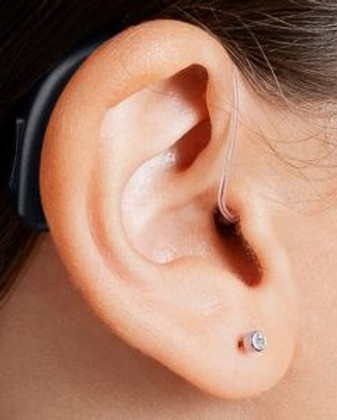All About
Hearing Aids
What is a Hearing Aid
A hearing aid is an electronic device that amplifies sound at different levels for different pitches. Hearing aids consist of a microphone, amplifier and receiver. This brief video of Dr. Tina Childress explains what a hearing aid is:
-
Microphones - Electronic devices that pick up sound (an acoustical signal) and changes it to an electrical signal in the hearing aid. There are several types of microphones which can be used in hearing aids. Some microphones can assist with listening in background noise. Ask an audiologist for more information.
-
Volume Up/Program Button - Used to increase the volume of the hearing aid, it is also used to select different pre-determined programs that have been set up in the hearing aid.
-
Volume Down/Program Button - Used to increase the volume of the hearing aid, it is also used to select different pre-determined programs that have been set up in the hearing aid.
-
Indicator Light - Different colors will mean different things, ask your audiologist to list what each color means.
-
Battery Door - This is where the hearing aid battery will be inserted, pediatric hearing aids have a locking door to protect your child from accessing the battery.
-
Ear Hook - A plastic attachment that connects to the hearing aid and loops over the top of the ear. The ear hook attaches the hearing aid to the tubing which attaches to the ear mold which is inserted into the ear.

How do Hearing Aids Work?

Types of Hearing Aids for children

Behind the Ear (BTE)
-
Most durable hearing aid because no electronics are inside the ear canal
-
Best retention
-
Ideal for young children

Receiver-in-Canal (RIC)
-
Delicate hearing aid because some electronics are behind the ear and some are inside the ear
-
More discrete than BTE
-
Ideal for responsible teens
Battery versus Rechargeable Hearing Aids

Battery
-
Child is never without sound
-
Batteries are poisonous if ingested. A child-proof lock must be used for young children.
-
Must buy disposable batteries
Disposable Batteries

Rechargable
-
Family must remember to charge hearing aids every night for the child to hear
-
No choking hazard
How to use:
-
Peel battery tab right before you are ready to use it.
-
Allow hearing aid to sit without tab for a couple of minutes to air-activate.
-
Place hearing aid in battery.
Battery care:
-
Store batteries in a cool, dry place. Exposure to extreme temperatures will shorten their life.
-
Keep away from children and pets, as batteries are toxic. Battery Ingestion Hotline: (202) 625-3333
-
Batteries are sold at many retailers, including Amazon, Walgreens, and Costco.

Hearing Aid Care Tips
Avoid water - remove devices before bathing.
Keep out of reach of pets.
Avoid contact with hair product.
Clean aid with a soft tissue, no liquid.
Questions to Consider Asking the Audiologist when Getting a Hearing Aid


